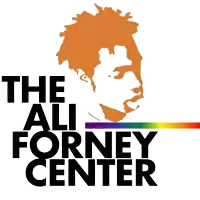Ali Forney Center
The Ali Forney Center (AFC), based in New York City, is the largest LGBT community center helping LGBTQ homeless youth in the United States.[1] The AFC both manages and develops transitional housing for its clients.[2] AFC helps approximately 2,000 youth clients each year, primarily between sixteen and twenty-four years old.[3] AFC is named after Ali Forney, a transgender youth who was murdered in New York in 1997.[3]
 | |
| Abbreviation | AFC |
|---|---|
| Named after | Ali Forney |
| Formation | 2002 |
| Founder | Carl Siciliano |
| Founded at | New York |
| Type | Non-governmental organization |
Executive Director | Alexander Roque |
| Website | aliforneycenter |
| Part of a series on |
| Living spaces |
|---|
 |
Description
AFC has 15 residential sites in Brooklyn, Queens and Manhattan. In 2012, AFC provided 77 beds a night for homeless LGBTQ youth.[4] AFC also runs a drop-in center, open 24/7, where clients can apply for housing, receive food and hygiene services and can access free medical and mental health care .[4] AFC Founder Carl Siciliano says that the clients served by the drop-in center are often in the most acute crisis.[5] AFC serves the LGBTQ population because they represent approximately forty percent of New York's young homeless people.[6]
History
AFC has served homeless LGBTQ youth in New York since 2002.[7] The organization was founded by Carl Siciliano.[3] When AFC first opened, it had only six beds.[8] Siciliano, who knew and respected Forney, recalls that it was a challenge to secure funding for the first two years of the organization's operation.[9] By 2007, AFC had 32 beds, 50 staff and offered wraparound services including free medical care, HIV testing, hygiene services, job training and job placement through the drop-in center.[10]
During the aftermath of Hurricane Sandy in 2012, the drop-in center was flooded.[5] A fundraiser hosted by Ally Sheedy helped raise money for the organization to relocate and reopen the drop-in center.[5] An additional $100,000 was raised in one day to help the organization through word of mouth and social media.[5]
In July 2015, AFC broke ground on its new Bea Arthur Residence.[11] The housing site is named after the actress, Bea Arthur, who left $300,000 in her will to AFC.[12] Arthur's endowment to the shelter enabled it stay open during the recession in 2009.[13] In 2012, the New York City Council and the Manhattan borough president provided $3.3 million to renovate the building that will house the Bea Arthur Residence.[12] In addition to the money that she left in her will, Arthur also helped raise $40,000 for AFC in 2005 with her one-woman show, "Bea Arthur on Broadway: Just Between Friends."[14]
The organization has received donations from other sources as well in order to expand and help maintain operating costs. In 2009, the Episcopal Diocese of Long Island donated $200,000 to help the organization stay open after losing nearly $450,000 in funding due to the economic downturn.[3]
See also
References
- Rawles, Timothy (July 19, 2015). ""Golden Girls" actress Bea Arthur funds LGBT homeless shelter in her will". San Diego Gay & Lesbian News. Archived from the original on July 21, 2015. Retrieved July 21, 2015.
- MacBride, Elizabeth (July 14, 2015). "The Star Entrepreneur Donates So That Others May Build Homes, Schools". Crain's New York Business. Archived from the original on April 29, 2017. Retrieved July 22, 2015.
- Ong, Bao (December 8, 2009). "Church Aids Expansion of Shelter for Gay Youths". City Room Blog from The New York Times. Archived from the original on December 11, 2017. Retrieved July 22, 2015.
- Dunlap, David W. (November 20, 2012). "Homeless Gay and Transgender Youths Find a New Home in Greenwich Village". City Room Blog of The New York Times. Archived from the original on September 6, 2015. Retrieved July 22, 2015.
- D'Addario, Daniel (November 9, 2012). "Ali Forney Center Throws Fundraising Bash for Flooded Drop-In Center". New York Observer. Archived from the original on July 16, 2023. Retrieved July 22, 2015 – via Regional Business News - EBSCO.
- Lewis, Rebecca (February 25, 2015). "New Report Finds Sex Equals Survival for Many Homeless LGBTQ Youth". WFUV Public Radio. Archived from the original on March 4, 2016. Retrieved July 22, 2015 – via National Public Radio.
- Pedro, Joseph (July 9, 2015). "Celebrate Summer with the Ali Forney Center in New York City". Passport Magazine. Archived from the original on July 23, 2015. Retrieved July 22, 2015.
- Thrasher, Steven W. (November 4, 2011). "A Church. A Shelter. Is It Safe?". The New York Times. Archived from the original on February 1, 2014. Retrieved July 22, 2015.
- Beale, Lewis (May 31, 2007). "Homeless Man Inspires Shelter From the Storm". Back Stage East. 48 (22): 9. Archived from the original on July 16, 2023. Retrieved July 22, 2015. – via EBSCO (subscription required)
- Henderson, William (September 25, 2007). "The New Order". Advocate (993): 111. Archived from the original on July 16, 2023. Retrieved July 22, 2015. – via EBSCO (subscription required)
- "Bea Arthur Homeless Shelter Breaks Ground". Washington Blade. July 15, 2015. Archived from the original on July 22, 2015. Retrieved July 22, 2015.
- Garner, Glenn (July 16, 2015). "Bea Arthur LGBT Shelter to Break Ground". Out. Archived from the original on July 23, 2015. Retrieved July 22, 2015.
- "Work Begins in Village on Bea Arthur Residence for LGBT Homeless Youth". Metro. July 19, 2015. Archived from the original on July 22, 2015. Retrieved July 22, 2015.
- Shapiro, Lila (July 21, 2015). "A Golden Girl's Legacy Brings Hope to LGBT Youth". Huffington Post. Archived from the original on July 23, 2015. Retrieved July 22, 2015.